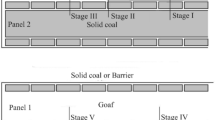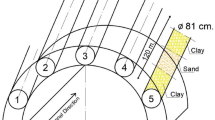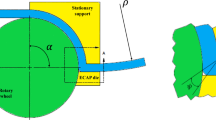Abstract
This paper provides a feasible scheme for robust optimization of the ramming process of a chain ramming machine with multiple clearances using a data-driven modeling framework based on deep neural networks. The forced ramming process of the chain ramming machine is studied, and a specially tailored experimental platform is demonstrated to validate the multiple clearances combined dynamic model of the ramming machine. In the model, the spatial clearances of the rollers in the track and sprocket teeth grooves and of the projectile in the conveying channel are described in detail for the first time. The displacements, velocities and lateral and vertical swing angles of the projectile when the projectile is forced in place with different combinations of clearances serve as the training dataset for the data-driven-forced ramming model. On this basis, the architecture of the deep neural network for the forced ramming process is designed by an integer optimization method to establish the corresponding data-driven model. Finally, a multiobjective robust optimization study is carried out under the data-driven model, and the optimization results with considering controllable and uncontrollable variance provide a reference for the project to improve the accuracy of ramming projectiles in place.


















Similar content being viewed by others

Data availability
The datasets generated and analyzed during the current study are available from the corresponding author on reasonable request.
Abbreviations
- \(F_{n}\) :
-
Normal contact force
- \({\mathbf{F}}_{t}\) :
-
Tangential friction
- \({\mathbf{P}}\) :
-
The array of independent joint variables
- \({\mathbf{H}}\) :
-
Conversion matrix
- \({\mathbf{M}}\) :
-
Mass matrix of the system
- \({\mathbf{C}}\) :
-
Flexibility matrix of the system
- \({\mathbf{w}}_{i}\) :
-
Weight matrix of the neural network
- \({\mathbf{b}}_{i}\) :
-
Threshold matrix of the neural network
- \( f_{A}(\cdot)\) :
-
Activation function
- \(\delta\) :
-
Normal penetration depth of the contact point
- \(\dot{\delta }\), \({\dot{\mathbf{\tau }}}\) :
-
Normal and tangential relative velocity
- \(N_{h}\) :
-
The number of hidden layers
- \(N_{{\varvec{n}}}\) :
-
The number of neurons each hidden layer
- \({\mathbf{R}}^{2}\) :
-
The goodness-of-fit index
- \({\mathbf{P}}_{\text{v}}\) :
-
The random variation in uncontrollable parameters
- \({\mathbf{P}}_{{\varvec{c}}}\) :
-
The nonrandom variation uncontrollable parameters
- \({\mathbf{X}}_{{\varvec{v}}}\) :
-
The random variation in controllable parameters
- \({\mathbf{X}}_{{\varvec{c}}}\) :
-
The nonrandom controllable parameters.
- \({\mathbf{u}}_{y}\), \({{\varvec{\upsigma}}}_{y}\) :
-
The mean and variance of the dynamic responses of the projectile
References
Tian, Q., Flores, P., Lankarani, H.M.: A comprehensive survey of the analytical, numerical and experimental methodologies for dynamics of multibody mechanical systems with clearance or imperfect joints. Mech. Mach. Theory 122, 1–57 (2018). https://doi.org/10.1016/j.mechmachtheory.2017.12.002
Song, N., Peng, H., Kan, Z., Chen, B.: A novel nonsmooth approach for flexible multibody systems with contact and friction in 3D space. Nonlinear Dyn. 102, 1375–1408 (2020). https://doi.org/10.1007/s11071-020-05972-1
Ma, J., Qian, L., Chen, G., Li, M.: Dynamic analysis of mechanical systems with planar revolute joints with clearance. Mech. Mach. Theory 94, 148–164 (2015). https://doi.org/10.1016/j.mechmachtheory.2015.08.011
Song N, Peng H, Xu X, Wang G: Modeling and simulation of a planar rigid multibody system with multiple revolute clearance joints based on variational inequality. Mec. Mach. Theory 154, 104053 (2020). https://doi.org/10.1016/j.mechmachtheory.2020.104053
Wang, X., Lv, J., Wang, Q.: A numerical method for dynamics of plannar multi-rigid-body system with frictional translational joints based on LuGre friction model. Chinese J. Theor. Appl. Mech. 51, 209–217 (2019)
Zheng X, Zhang R, Wang Q: Comparison and analysis of two Coulomb friction models on the dynamic behavior of slider-crank mechanism with a revolute clearance joint. App.l Math. Mech. (English edn) 39, 1239–1258 (2018). https://doi.org/10.1007/s10483-018-2371-9
Zheng, X., Zhang, F., Wang, Q.: Modeling and simulation of planar multibody systems with revolute clearance joints considering stiction based on an LCP method. Mech Mach Theory 130, 184–202 (2018). https://doi.org/10.1016/j.mechmachtheory.2018.08.017
Zhou Z, Zheng X, Wang Q, Chen Z, Sun Y, Liang B: Modeling and simulation of point contact multibody system dynamics based on the 2D LuGre friction model. Mech. Mach. Theory 158, 104244 (2021). https://doi.org/10.1016/j.mechmachtheory.2021.104244
Wan, Q., Liu, G., Song, C., Zhou, Y., Ma, S., Tong, R.: Study on the dynamic interaction of multiple clearance joints for flap actuation system with a modified contact force model. J. Mech. Sci. Technol. 34, 2701–2713 (2020). https://doi.org/10.1007/s12206-020-0603-8
Chen, Y., Sun, Y., Chen, C.: Dynamic analysis of a planar slider-crank mechanism with clearance for a high speed and heavy load press system. Mech. Mach. Theory 98, 81–100 (2016). https://doi.org/10.1016/j.mechmachtheory.2015.12.004
Li, Y., Wang, Z., Wang, C., Huang, W.: Planar rigid-flexible coupling spacecraft modeling and control considering solar array deployment and joint clearance. Acta Astronaut 142, 138–151 (2018). https://doi.org/10.1016/j.actaastro.2017.10.008
Zheng, E., Zhou, X.: Modeling and simulation of flexible slider-crank mechanism with clearance for a closed high speed press system. Mech. Mach. Theory 74, 10–30 (2014). https://doi.org/10.1016/j.mechmachtheory.2013.11.015
Marques, F., Isaac, F., Dourado, N., Flores, P.: An enhanced formulation to model spatial revolute joints with radial and axial clearances. Mech. Mach. Theory 116, 123–144 (2017). https://doi.org/10.1016/j.mechmachtheory.2017.05.020
Liu, T., Qian, L., Yin, Q.: Kinematics accuracy and dynamic analysis of multi-body system with spatial cylindrical clearance joint. J. Vib. Shock 36, 7 (2017)
Liu, C., Tian, Q., Hu, H.: Dynamics and control of a spatial rigid-flexible multibody system with multiple cylindrical clearance joints. Mech. Mach. Theory 52, 106–129 (2012). https://doi.org/10.1016/j.mechmachtheory.2012.01.016
Tian, Q., Lou, J., Mikkola, A.: A new elastohydrodynamic lubricated spherical joint model for rigid-flexible multibody dynamics. Mech. Mach. Theory 107, 210–228 (2017). https://doi.org/10.1016/j.mechmachtheory.2016.09.006
Castelli, V.P., Venanzi, S.: Kinetostatic modeling of the clearance-affected prismatic pair. J. Robot. Syst. 22, 487–496 (2005). https://doi.org/10.1002/rob.20081
Wu, X., Sun, Y., Wang, Y., Chen, Y.: Dynamic analysis of the double crank mechanism with a 3D translational clearance joint employing a variable stiffness contact force model. Nonlinear Dyn. 99, 1937–1958 (2020). https://doi.org/10.1007/s11071-019-05419-2
Tang, L., Liu, J.: Modeling and analysis of sliding joints with clearances in flexible multibody systems. Nonlinear Dyn. 94, 2423–2440 (2018). https://doi.org/10.1007/s11071-018-4500-y
Tang, L., Liu, J.: Frictional contact analysis of sliding joints with clearances between flexible beams and rigid holes in flexible multibody systems. Multibody Syst. Dyn. 49, 155–179 (2020). https://doi.org/10.1007/s11044-019-09717-w
Bauchau, O.A., Bottasso, C.L.: Contact Conditions for Cylindrical, Prismatic, and Screw Joints in Flexible Multibody Systems. Multibody Syst. Dyn. 5, 251–278 (2001). https://doi.org/10.1023/A:1011461223706
Liu Q, Lu SN, Ding XL: An error equivalent model of revolute joints with clearances for antenna pointing mechanisms. Chinese J Mech Eng (English Edn) 31, 1–9 (2018). https://doi.org/10.1186/s10033-018-0233-6
Zheng, K., Chen, H., Zhang, Q., Zeng, S.: Study the micro chaotic phenomena and its control of rigid-flexible robot. J Mech. Sci. Technol. 36, 2597–2609 (2022). https://doi.org/10.1007/s12206-022-0440-z
Chen, X., Wu, R., Jia, Y.: Dynamic response and chaotic characteristics analysis of spatial parallel mechanisms with multiple spherical clearance joints. J. Vib. Eng. Technol. 10, 471–497 (2022). https://doi.org/10.1007/s42417-021-00387-7
Zhao Q, Guo J, Hong J: Closed-form error space calculation for parallel/hybrid manipulators considering joint clearance, input uncertainty, and manufacturing imperfection. Mech. Mach. Theory 142, 103608 (2019). https://doi.org/10.1016/j.mechmachtheory.2019.103608
Etesami, G., Felezi, M.E., Nariman-Zadeh, N.: Optimal transmission angle and dynamic balancing of slider-crank mechanism with joint clearance using Pareto Bi-objective Genetic Algorithm. J. Brazilian Soc. Mech. Sci. Eng. 43, 185 (2021). https://doi.org/10.1007/s40430-021-02834-8
Wu, H., Zhang, Y., Yan, S.: Effect of driving functions with different jerk and accelerating time length on dynamic performance for mechanical systems: analysis and optimization. J Mech. Sci. Technol. 36, 2225–2238 (2022). https://doi.org/10.1007/s12206-022-0406-1
Li, Y., Chen, G., Sun, D., Gao, Y., Wang, K.: Dynamic analysis and optimization design of a planar slider-crank mechanism with flexible components and two clearance joints. Mech. Mach. Theory 99, 37–57 (2016). https://doi.org/10.1016/j.mechmachtheory.2015.11.018
Vedrtnam, A., Singh, G., Kumar, A.: Optimizing submerged arc welding using response surface methodology, regression analysis, and genetic algorithm. Def. Technol. 14, 204–212 (2018). https://doi.org/10.1016/j.dt.2018.01.008
Sun, D., Zhang, B., Liang, X., Shi, Y., Suo, B.: Dynamic analysis of a simplified flexible manipulator with interval joint clearances and random material properties. Nonlinear Dyn. 98, 1049–1063 (2019). https://doi.org/10.1007/s11071-019-05248-3
Chen, C., Long, J., Chen, W., Liu, Z., Guo, J.: Modeling and prediction of spindle dynamic precision using the Kriging-based response surface method with a novel sampling strategy. Nonlinear Dyn. 111, 559–579 (2022). https://doi.org/10.1007/s11071-022-07861-1
Zhou Y, Lu Z, Yun W: Active sparse polynomial chaos expansion for system reliability analysis. Reliab. Eng. Syst. Saf. 202, 107025 (2020). https://doi.org/10.1016/j.ress.2020.107025
Wang, L., Yang, G.: An interval uncertainty propagation method using polynomial chaos expansion and its application in complicated multibody dynamic systems. Nonlinear Dyn. 105, 837–858 (2021). https://doi.org/10.1007/s11071-021-06512-1
Chen J, Chen L, Qian L, Chen G, Zhou S: Time-dependent kinematic reliability analysis of gear mechanism based on sequential decoupling strategy and saddle-point approximation. Reliab. Eng. Syst. Saf. 220, 108292 (2022). https://doi.org/10.1016/j.ress.2021.108292
Górski, J., Klepka, A., Dziedziech, K., Mrówka, J., Radecki, R., Dworakowski, Z.: Identification of the stick and slip motion between contact surfaces using artificial neural networks. Nonlinear Dyn. 100, 225–242 (2020). https://doi.org/10.1007/s11071-020-05515-8
Onler, R., Koca, A.S., Kirim, B., Soylemez, E.: Multi-objective optimization of binder jet additive manufacturing of Co-Cr-Mo using machine learning. Int. J. Adv. Manuf. Technol. 119, 1091–1108 (2022). https://doi.org/10.1007/s00170-021-08183-z
Peng, H., Song, N., Kan, Z.: Data-driven model order reduction with proper symplectic decomposition for flexible multibody system. Nonlinear Dyn. 107, 173–203 (2022). https://doi.org/10.1007/s11071-021-06990-3
Cheng F, Xu H, Feng X: Model order reduction method based on (r)POD-ANNs for parameterized time-dependent partial differential equations. Comput. Fluids 241, 105481 (2022). https://doi.org/10.1016/j.compfluid.2022.105481
Ma J, Dong S, Chen G, Peng P, Qian L: A data-driven normal contact force model based on artificial neural network for complex contacting surfaces. Mech. Syst. Signal Process. 156, 107612 (2021). https://doi.org/10.1016/j.ymssp.2021.107612
Ma J, Wang J, Han Y, Dong S, Yin L, Xiao Y: Towards data-driven modeling for complex contact phenomena via self-optimized artificial neural network methodology. Mech. Mach. Theory182, 105223 (2023). https://doi.org/10.1016/j.mechmachtheory.2022.105223
Peng H, Song N, Li F, Tang S: A mechanistic-based data-driven approach for general friction modeling in complex mechanical system. J. Appl. Mech. Trans. ASME 89 (2022). https://doi.org/10.1115/1.4054484
Chen G: The Study on the Dynamic of the Projectile-Barrel Coupled System and the Corresponding Key Parameters. Nanjing University of Science and Technology (2016)
Goodfellow I, Bengio Y, Courville A: Deep Learning. MIT press (2016)
Acknowledgements
This work was supported by the National Natural Science Foundation of China (Grant No. 11472137) and the Fundamental Research Funds for the Central Universities (Grant Nos. 309181A8801 and 30919011204).
Funding
This work was supported by the National Natural Science Foundation of China (Grant No. 11472137) and the Fundamental Research Funds for the Central Universities (Grant Nos. 309181A8801 and 30919011204).
Author information
Authors and Affiliations
Contributions
All authors contributed to the study conception and design. YL and LQ performed formula derivation, numerical calculation, and data collection. YL and WH performed data analyses. The first draft of the manuscript was written by YL. GC commented on and revised the previous versions of the manuscript. All authors read and approved the final manuscript.
Corresponding author
Ethics declarations
Conflict of interest
On behalf of all authors, the corresponding author states that there is no conflict of interest.
Additional information
Publisher's Note
Springer Nature remains neutral with regard to jurisdictional claims in published maps and institutional affiliations.
Rights and permissions
Springer Nature or its licensor (e.g. a society or other partner) holds exclusive rights to this article under a publishing agreement with the author(s) or other rightsholder(s); author self-archiving of the accepted manuscript version of this article is solely governed by the terms of such publishing agreement and applicable law.
About this article
Cite this article
Li, Y., Qian, L., Chen, G. et al. Multiple clearance robustness optimization of a chain ramming machine based on a data-driven model. Nonlinear Dyn 111, 13807–13828 (2023). https://doi.org/10.1007/s11071-023-08589-2
Received:
Accepted:
Published:
Issue Date:
DOI: https://doi.org/10.1007/s11071-023-08589-2



